The Bike Gang
2018
The Bike Gang_06_Maasai Mbili_2017_(c)Johan
Bikes, Bazes And Belonging - Sam Hopkins
Excerpt from Distributed: Co-producing Narratives Of Belonging in Nairobi's Eastlands. PhD thesis, UAL, Supervisors: N. Cummings, J. Bajorek
Back To The Baze
The baze is the social space par excellence of Nairobi’s Eastlands. Located at street corners, in improvised shacks, on unoccupied plots of land and other semi-public spaces, bazes are places where young people come together out of a shared interest. There are football bazes, runners bazes, hip hop bazes, bazes to play scrabble, bazes for reading, bazes to chew miraa, bazes for drinking, bazes for smoking, bazes for doing heroin and bazes for criminals, to name a few. Bazes are spaces for the expression of various and varied youth identities, and they extend throughout Nairobi in an intricate and interconnected network, orientated around tastes and affiliations.
Sheng is the lingua franca of these spaces, although its specific lexicon changes from baze to baze as a means of distinguishing one group from another. One word in one baze can mean something totally different in another baze.(1) The literal and metaphorical grammar of inclusion is shaped by the activities and affiliations of the baze. In bazes where the denizens are studying computers, the spoken Sheng takes on some of this vocabulary; in bazes affiliated with a strand of global youth culture, such as hip hop and reggae, an affinity and affiliation with this scene is an integral element of being included in the baze.(2)(3) But as well as spaces within which a specific variant of Sheng is practised, we can also see bazes as a kind of spatial equivalent to Sheng, a site for the performance of multiple identities.
Bazes, as multi-ethnic, social spaces where people spend time together, seemed to be fertile spaces within which to both experience and distribute A Life in the Day on smartphones. They are fundamentally discursive spaces for discussion and debate, where the inquiry into lived, yet elusive, ethnic identities could be further explored and tested. As well as physical sites of congregation, they are the material manifestation of a community, and network of affiliation, that is otherwise intangible. And as the members of the baze have smartphones, the baze also represents a node and connection to a digital community of affiliation.
I was personally allied with the idea of what bazes seemed to represent. As self-determined and self-regulated spaces they gave the impression of being resilient to, or able to negotiate with, the formal and informal power structures of Nairobi. As multi-ethnic spaces they appeared to counter a dominant narrative of how Kenyans and Nairobians congregate and socialise. And as active sites of debate and discussion they suggested a practice of language and rhetoric that was not registered by statistics of literacy and education. I had spent time in various bazes: Reebok baze in Ayani, Ghost town in Olympic and Toluro in Kianda. I was about to discover Off Road Base in Githurai.(4)
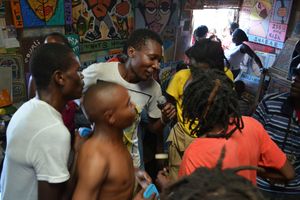
The Bike Gang_06_Maasai Mbili_2017_(c)Johan
Introducing The Off Road Base
The Off Road Base is located on the Northeastern fringe of Nairobi in Githurai 45, a neighbourhood of concrete tenement buildings and wooden and corrugated aluminium structures. Seen from the perspective of counter-narratives, the baze is an extremely symbolic place.(5) It is literally interstitial; constructed on a narrow strip of land between the road and the railway, legally impossible; built on the ‘rail reserve’ that belongs to the Kenya Railways Corporation (KRC), but informally allowed; leased through a network of middlemen along with a number of other small businesses in the areas.(6) The Off Road Base is a multi-purpose space, a successful business where four mechanics fix and sell bikes, a market place where riders meet to trade and swop parts and a literal and symbolic centre in the amateur bike racing scene. A blackboard nailed to the beam in the middle of the space announces the time, date and details of the next biking fixture.
At around 4pm on a typical weekday, as the sun starts to lose its intensity, a group of approximately ten young men congregate here. Arriving individually, they take a seat on the narrow benches that form an L-shape running around the open-sided structure, and settle in for the afternoon. Some bring mogoka (khat), a mild stimulant leaf, some bring locally-produced spirits, some cigarettes and some marijuana.(7) A few come to tulia (to relax/chill) and sit quietly, perhaps reading a paper or checking their phone, chewing, smoking or drinking in silence. Others are here to talk and passionately discuss wide- ranging topics, from celebrity gossip, to football chat, to politics. As dusk approaches at roughly 6pm, a vendor passes selling ginger coffee signalling the end of the day. People slowly drift off home or to continue the session somewhere else.
This form of assembly is extremely significant for the performance, and for the representation, of a particular constellation of identities. The Off Road Base is a bike baze and the men that come here, in varying degrees and in differing manners, are interested in bikes. The denizens of the baze share an interest and a passion, identities that they have adopted rather than been assigned. But what really piqued my curiosity, and resonated with this research, was the rich and idiosyncratic media ecology that the baze evidenced. Smartphones were used to document, watch and share short clips of biking skill and performances; they seemed to be a constitutive element in the fashioning of these bike-related identities. Seen through my research into the performance of belonging and the practices of representation, this was very exciting.
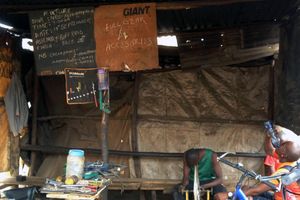
The Bike Gang_01_Production Still_2017_(c)Hopkins-Kamicha-30
Moving-Image In The Off Road Base
Biking is a clear theme and narrative that runs through the ongoing discussions at the baze, but it is not the exclusive domain of conversation. Involved discussions about whether Contador or Froome is a better racer can segue into arguments about who won the latest local amateur race which can then move onto the endemic corruption in the Kenyan biking scene, morph into a rant about Kenyan politics, international politics and then switch back to who has a new bike and/or has wiped out recently.(8) At some stage in this flow, perhaps to prove or counter a point in the discussion, a smartphone is produced.
The members of the Off Road Base habitually used their phones to show moving- image that they had produced themselves. This tended to revolve around biking, ranging from arduous hill-climbing to fast urban riding to the favourite, hanging, the practice of cycling in the slipstream of lorries on the motorway. Cycling at 100 km/h is a specialised skill in which the rider is reading and responding to all sorts of information. The men at the bike baze would watch these clips attentively, analysing the finely calibrated distance between the bike and lorry, the fingers hovering on the brake levers and the tremble in the handlebar. The clips of hanging commanded a particular attention to detail but all the self-produced clips at the baze were viewed with a keen level of scrutiny.
As a visual artist interested in identity as a series of overlapping performances of belonging in everyday Kenyan life, and exploring smartphones as an alternative media ecology, the existence of this practice of representation was extremely compelling. The young men at the Off Road Base were engaged in producing, collectively-viewing and distributing representations of themselves, performing as bikers. I had imagined bazes, as physical manifestations of intangible networks, might be possible sites for distributing content. But the Off Road Base evidenced a far more sophisticated media ecology that informed the scene that it was representing. The cycle of production, consumption and sharing of self-made moving-image implied a kind of feedback loop, shaping a representation practice, such as hanging, and a constellation of biking-related identities.
The significance of this smartphone-mediated, moving-image practice was catalysed by its location in a baze. The Off Road Base is an autonomous space of affiliation but it is also one part of an extensive, distributed network of bazes that extends across Nairobi. The embedded role of smartphones in the construction and dissemination of a biking identity in the Off Road Base suggested the possibility of similar processes taking place in the other tens of thousands of bazes across the city, constructing and disseminating alternative and multiple identities. This image of potentially vast and productive networks of belonging powerfully contested the reductive relationship of Kenyans with their ethnicity.
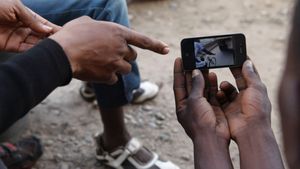
The Bike Gang_01_Production Still_2017_(c)Hopkins-Kamicha-17
Biking In Nairobi
“...how dare prosecutor Ocampo, “someone who rides a mere bicycle to work” summon their (Kenya’s) leader?” (9)
To be a biker in Nairobi evokes a heritage of the dispossessed and a tradition of being an outsider. Which is to say that The Off Road Base is not just an abstract exemplar of a performative notion of identity and its attendant representation practices. Bicycles, and the bicycle scene, have a specific texture and play a distinct role in Kenya. A combination of dangerous traffic, an insecure urban environment, a hilly landscape and a scarcity of affordable, good quality bikes meant that riding a bike in the city was never a widespread form of getting around Nairobi.(10)
Still, in some situations, and for some people, bicycles are the most suitable vehicles. The typical user of the locally available, cheaply made and unwieldy Chinese bike, the Phoenix, (universally known as a black mamba in Kenya) is a delivery man or an askari (security guard). Although heavy, black mambas can be easily customised with sturdy frames to transport produce such as eggs and bread, and can deliver to kiosks that are not on the main road. For askaris going home in the early morning after a night shift, when there is no traffic and few matatus, they are the fastest form of transport. But within the broader context of transport options, dominated by matatus, using a bike has been a marginal activity and the domain of the very poor. The direct associations between poverty and bikes was manifested in the indignation of some Kenyans that the President of Kenya was being tried at the International Criminal Court (ICC) by a judge who rode a bicycle to court.
It is precisely this sense of taboo that is part of the appeal of biking for Kamicha, a friend and fellow artist who introduced me to the Off Road Base. The idea of a biker as outsider, as different, as not really fitting in, is a key part of Kamicha’s biking identity. As he says: “Kenyan society has a problem with the bicycle, sometimes they say you are a pedestrian, sometimes they say you are a vehicle, you are always (being) confused”.(11) Kamicha is a singular, maverick individual but choosing to be a biker as a conscious statement of difference is a common thread in a growing and diversifying scene of bike enthusiasts that I met throughout Nairobi.(12) For example, most of the artists in Nairobi go by bike, partially because they have been converted by Kamicha, but also because they are a group who both consider themselves, and to some extent are, outsiders.(13) Cycling is a statement of difference; as the author of the blog shecyclesnairobi puts it “Ride hard or go home”.(14)
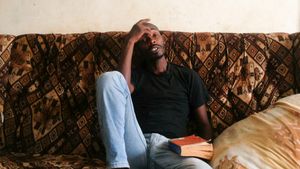
The Bike Gang_01_John Kamicha_2017_(c)Hopkins-Kamicha-43
This oppositional nature of Nairobi riders, the celebration of being different, coupled with a distinct mode of dress, way of speaking and various other rituals of inclusion and exclusion suggest that biking in Nairobi could be seen as a subculture. But I am wary of employing subculture as concept and analytical framework for this context. The scholarship on subcultures broadly frames them as deviance, resistance or distinction within a broader mainstream and class-based society.(15) But my line of argument into biking in Nairobi is to look at this as a performance of an identity that counters narratives and assumptions about Kenya as an ethnic-based society. Using the term and field of study of subculture would demand an evaluation of the relationship between ethnicity and class in Kenyan society which is extremely complicated and contested, and not the direct topic of this inquiry.(16) I refer instead to the bike scene.(17)
Riding a bike in Nairobi is not just about being rebellious and being an outsider; there is an increasing set of very practical reasons to ride a bike. The road network of Nairobi has been rebuilt and restructured with smoother, wider roads, many of which have bike lanes, so it is much easier and smoother to ride a bike then it used to be.(18) Traffic has become much worse as the Kenyan population expands, and for many journeys it is significantly faster to go by bicycle.(19) Second-hand mountain bikes and road bikes have become much easier to get hold of and easier to repair. And for many people there are clear economic advantages to going by bicycle.(20) These developments have lead to an expanding and diversifying biking vanguard, encompassing the Off Road Base, the Kuona Trust Collective, the author of shecyclesnairobi as well as globally-net- worked events such as a Critical Mass and Shorts on Wheels.(21) (22)
I joined this growing group. Bikes are a passion of mine; I own several and enjoy fixing them. But more than liking bicycles, I like the movement they afford. Bikes give me an autonomy that other forms of transport do not. The feeling of powering myself, of being able to go (almost) anywhere, gives me a sense of independence, ownership and belonging in a city. I think part of this might be because bike riding affords a certain kind of looking. When I ride through the city I have the feeling that I move at a pace slow enough to look around, but fast enough not to attract attention. Bearing this in mind, it is amazing that I did not start riding a bike around Nairobi sooner. But at a certain point in 2015, the pain of being in traffic, the allure of riding a bike and the fact that all my friends started riding bikes broke the taboo surrounding bikes. So I got in touch with Kamicha.
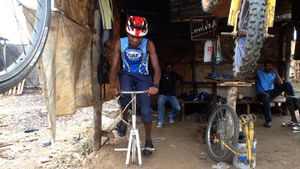
The Bike Gang_01_Production Still_2017_(c)Hopkins-Kamicha-15
--
Notes
- Peter Githinji uses the term baze to designate both the physical space and the community that congregates there. He illustrates how Sheng words can have completely different meanings in different bazes. For example Kumanga (deriving from the French manger - to eat) means to eat or have sex in the neighbourhood of Sinai, but means to steal in Kibera. See ‘Bazes and Their Shibboleths: Lexical Variation and Sheng Speakers’Identity in Nairobi’. Nordic Journal of AfricanStudies. 15, 4 (2006), p. 462.
- Githinji references a baze in Ngara where all the members were doing a computing course and hence referred to caressing a girl as ‘browsing’. Githinji, Bazes and Their Shibboleths, p. 457.
- The yard behind the National Theatre in downtown Nairobi is a baze for hip hop and reggae musicians and a site of daily freestyling and jam sessions. It is also a rare space in downtown Nairobi where it is possible, although not legal, to smoke marijuana. Nevertheless it is not a baze where anyone can come and smoke; this privilege is reserved for the genuine musicians and close affiliates.
- As Sheng is not a written language there are variations in the written form of words. Baze tends to be written with a z. Off Road Base, however, is written with an s.
- Bazes evoke many of the oppositional, underground, anti-establishment characteristics of Hakim Bey’s Temporary Autonomous Zone (TAZ). “The TAZ is like an uprising which does not engage directly with the State, a guerilla operation which liberates an area (of land, of time, of imagination) and then dissolves itself to re-form elsewhere/else before the State can crush it.” Hakim Bey, ‘The Temporary Autonomous Zone’ in Peter Ludlow Wilson, Crypto Anarchy, Cyberstates and Pirate Utopias (Cambridge MA, London: MIT Press, 2001) p. 404.
- For an informative account of the baroque corruption of Nairobi City Council see ‘Africa Uncensored,’ Kanjo Kingdom, April 4, 2016, https://www.youtube.com/ watch?v=IGMnFQTiwNg (March 5, 2018).
- “The bitter-tasting leaves and young buds are chewed for the stimulants cathinone and cathine, which produce a mild euphoria.” See ‘Khat,’ https://www.britannica.com/plant/ khat-plant (March 9, 2018).
- Albert Contador and Chris Froome are professional cyclists. Chris Froome was born and raised in Kenya and trained by the Kenya trainer David Kinjah. See Colin Henrys, ‘Interview: David Kinjah – the man who discovered Chris Froome’, August 24, 2015, https://roadcyclinguk.com/racing/interview- david-kinjah-the-man-who-discovered-chris- froome.html#XkjFvIVYTLvRg2Ah.97 (March 5, 2018).
- The quote refers to Luis Moreno Ocampo, the chief prosecutor of the International Criminal Court (ICC), who would ride a bicycle to the court building in The Hague. The President of Kenya, Uhuru Kenyatta, was accused of crimes against humanity and was the first sitting head of state to appear before the ICC. Oumar Ba, ‘Kenyatta went to The Hague: how to bet and win against the (international) system’, October 20, 2014, http://africasacountry.com/2014/10/ kenyatta-went-to-the-hague-how-to-bet-and- win-against-the-international-system/ (March 5, 2018).
- “Riding a bike, which children love, is also out of the question...”. See Jackie Klopp, ‘Children’s needs ignored in Nairobi’s physical planning’, April 6, 2016, https://www.nation. co.ke/lifestyle/dn2/Children-PLAY-ignored- in-Nairobi-physical-planning/957860- 3148798-format-xhtml-11x40xl/index.html (March 5, 2018).
- See The Bike Gang_Trailer (2016), https:// vimeo.com/155176988 min 00.30-40 (March 5, 2018) min. 00:31-00:47.
- Kamicha is an outspoken and uncompromising critic of Kenyan society. He is also the only artist in contemporary times to have had his work censored in an exhibition. Margaretta wa Gacheru, ‘”Sex and the City” accused of blasphemy,’ April 30, 2014, https://thisisafrica.me/lifestyle/ sex-city-accused-blasphemy/ (January 16, 2018).
- I refer here to the Kuona Artists Collective, the largest collection of professional artists in Nairobi, who might appear as outsiders in the sense that they do not earn their income regularly, work regular office hours or shift work, dress and behave unconventionally, See ‘Our Story’, https://www.facebook.com/pg/ Kuonaartistscollective/about/?ref=page_ internal (January 16, 2018).
- ‘Don’t Date A Girl Who Cycles in Nairobi’, https://shecyclesnairobi. wordpress.com/2014/02/04/dont-date-a- girlwhocyclesinnairobi/ (January 16, 2018).
- See Dick Hebdidge, Subculture: the meaning of style (London: Methuen & Co, 1979), Sarah Thornton, Club Cultures: Music, Media and Subcultural Capital (Cambridge: Polity Press, 1995). David Muggleton & Rupert Weinzerl (eds), The Post-Subcultures Reader (Oxford: Berg, 2003), Andy Bennet, ‘Subcultures or Neo-Tribes? Rethinking the Relationship between Youth, Style and Musical Taste’, Sociology Vol. 33, No.3 August 1999, pp. 599-617.
- See Angelique Haugerud, The Culture of Politic in Modern Kenya (Rutgers University: New Jersey, 1997).
- The designation ‘scene’ is useful as a less loaded term, yet it too has a genealogy within academia. John Irwin uses ‘scene’ in his study of what he terms the ‘Grand Scene’; hippies and surfers in the United States after the Second World War. He uses the term as it is the word used by the participants in these scenes, and also due to the “theatrical metaphor” of the word scene. The way in which a scene frames the individual as an actor in a transient world (rather than the solidified categories suggested by subculture) makes the term appropriate for this particular research. See John Irwin, Scenes (Beverley Hills & London: Sage, 1977) p. 23.
- The Thika Superhighway (2013) has a bike lane the whole way, although often it is filled with street vendors and can also be used by matatus as a short cut. The new road network around Kileleshwa Ring Road (2014) also has clearly-marked bike lanes, although often this is filled with pedestrians. See ‘half-a-pedestrian in Nairobi’, https://shecyclesnairobi.wordpress. com/2013/07/31/half-a-pedestrian-in-nairobi/ (March 6, 2018).
- Nic Cheeseman quotes Evans Kidero, the former Governor of Nairobi, saying that between 2012 and 2014 the number of cars in Nairobi doubled. See Nic Cheeseman, ‘Why traffic costs Kenya Sh2bn a year’, May 1, 2016, https://www.nation.co.ke/oped/ Opinion/-Why-traffic-costs-Kenya-Sh2bn- 25 a-year/440808-3183654-ftn3nn/index.html (March 9, 2018).
- Returning to the example of the artists in the Kuona Artist Collective, if you earn income through irregular sales of artwork, then there is a clear logic to investing that money in a bike.
- See ‘Critical Mass - October’, October 17, 2014, https://cyclenairobi.wordpress.com/ category/critical-mass/. (January 16, 2018).
- Della Mbaya, January 30 2017, ‘#ShortsOnWheels: When Nairobi’s Cycling And Film Communities Collide’ https://www. kenyanvibe.com/shortsonwheels-nairobis- cycling-film-communities-collide/ (March 6, 2018).